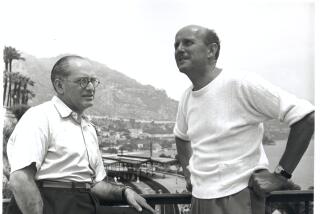From the Archives: Film Star William Powell Dies at 91
William Powell, the debonair film star who epitomized the suave, cosmopolitan leading man of the 1930s and 1940s, died early Monday of old age at Desert Hospital in Palm Springs, his attending physician said.
“The old gentleman went very nicely, said Dr. Irving Hirshleifer. Powell was 91.
With the tall, mustachioed veteran performer when he died was his wife of 44 years, former actress Diana Lewis.
Best know for Dashiell Hammett’s “Thin Man” detective series, Powell appeared in 95 films. He was nominated three times for an Oscar, but never won.
For the last several years, he lived quietly in Palm Springs, seldom leaving the home he shared with his wife, whom he called “Mousie.” His health had been gradually failing over the years, said Hirschleifer, and he was admitted to the hospital Sunday. He had survived rectal cancer in 1938.
During a 33-year film career he was often paired opposite the great leading ladies of the time, such as Carole Lombard, who was his second wife; Jean Harlow, to whom he reportedly was engaged at the time of her death in 1937; Joan Crawford, Bette Davis and Rosalind Russell. In most of those roles he was asked to be ever elegant and charming, fast to produce either clever one-liners or a bucket of champagne.
‘Thin Man’ Films
He made a dozen films with Myrna Loy, among them “The Great Ziegfeld” and “Libeled Lady” (both 1936), “Double Wedding” (1937) and “Love Crazy” (1941). But their most successful collaborations were as the urbane Nick and Nora Charles in six “Thin Man” films, exchanging bright and witty dialogue as they solved murder mysteries. The Thin Man actually was a nickname for the murderer’s victim in the first film of the series. But Powell became so closely identified with the character that the name stuck to him.
As an actor Powell was known for a distinctive voice and techniques which were so subtle that one colleague, Mark Stevens, who worked with him in “Dancing in the Dark” (1949), once said, “You wonder how he did it.”
But like many actors of his time, his craft was developed and honed long before Hollywood beckoned. For nearly 10 years he had labored in traveling stock companies and then on the Broadway stage.
Ironically, Powell’s roots were anything but urbane and sophisticated. He was born William Horatio Powell on July 29, 1892, the son of an accountant in Pittsburgh. In 1907, the family moved to Kansas City, and after an uneventful childhood he intended to go to the University of Kansas and become a lawyer.
But the bug of acting had bitten in two high school plays during his senior year. After one week at college, he dropped out and went to New York to study at the American Academy of Dramatic Arts.
Because his father opposed that move, Powell had to earn his tuition working for a telephone company and as an usher. He also secured a loan from an aunt with whom his father did not get along.
He got bit parts on Broadway and shuttled back and forth to stock companies and even vaudeville. In 1930 he landed a leading role in a Broadway romantic melodrama called “Spanish Love,” which ran for two years.
He had tried without success to get into motion pictures. Finally, in 1922, Sam Goldwyn hired him for a small role as a heavy in “Sherlock Holmes,” a silent starring John Barrymore.
More and larger roles followed, but during the 1920s he was almost always cast as the villain. He was a comic villain king opposite Marion Davies in “When Knighthood Was in Flower” (1922), a terrible husband opposite Lillian Gish in “Romola” (1924), an oily Italian thief in “Beau Geste” (1926) and a blackmailer in “Love’s Greatest Mistake” (1927).
Second in Talkies
The “talking” pictures that wiped out so many Hollywood careers enhanced Powell’s and liberated him from the long procession of bad-guy roles. His second talkie, as the dilettante detective Philo Vance in “The Canary Murder Case” (1929), was his first appearance as a suave sophisticate, and he immediately became a star.
Asked by a reporter years later if talkies had “hurried” his stardom, he snapped “Don’t be foolish. They caused it. But for talkies I would probably be a first class so-and-so in every picture. I was practically doomed by my face to play a screen menace.”
But that face combined with his voice turned around his image. He did two more Philo Vance detective mysteries, but thereafter was cast principally in drawing room comedies and madcapfarces. His work in one of these, “My Man Godfrey,” a 1936 film with Carole Lombard, gained him a second Oscar nomination.
The first film of the “Thin Man” series was released in 1934. According to some biographies, Metro-Goldwyn-Mayer production chief Louis B. Mayer, who had just gotten Powell under contract, did not think a Powell-Loy combination would succeed as the chic husband-wife team, and agreed to let director W.S. Van Dyke use them only if “The Thin Man” finished shooting in 12 days. It did, and became an instant hit.
Myrna Loy, now 78, said Monday through a New York spokesman:
“I never enjoyed my work more than when I worked with William Powell. He was a brilliant actor, a delightful companion, a great friend and above all a true gentleman. I have seen him frequently . . . over the years. I shall miss him terribly.”
Powell’s last Oscar nomination came as a departure from his man-of-the-world roles, when he appeared as the terrible-tempered Clarence Day in “Life With Father” (1947), which co-starred Irene Dunne and Elizabeth Taylor. He later said he had tried to persuade MGM for five years to buy rights to the famous play, and very much wanted that role. Released from MGM, he won it when a competing company, Warner Brothers, secured it, and dyed his hair and mustache bright red for the filming.
Last Picture
His last picture was made in 1954, when he portrayed the philosophical ship’s doctor in “Mister Roberts.” He look the part, he later said, to get a “free trip to Hawaii,” where the movie was being filmed.
After that he refused all offers, explaining, “The ham in me has been pretty well burned out.”
Powell married three times. His first wife, Eileen Wilson, was an actress he married in 1915, during his years in stock companies. Before their 1931 divorce, she bore him a son, William Jr., who committed suicide in 1968.
He married Lombard in 1931, a union that ended in 1933 before her marriage to Clark Gable. In 1940, he married Lewis, then an MGM contract player.
Powell had a reserved, retiring personality off screen, read a lot and was interested in music. But he had a good sense of humor, and once told how he and Loy played a practical joke on Sid Grauman by showing up wearing swimming flippers when called to put their footprints in wet cement outside Hollywood’s Chinese Theater.
“Sid went white when he saw them but hastily pretended he knew it was a gag,” Powell recalled, “and urged us to take them off. We played it straight and insisted the flippers were the only shoes we had and solemnly told him that we’d worn them deliberately so we could make a bigger ‘impression.’”
In his final years, Powell, still tall and dapper, with white hair and a trim white mustache, was described by friends as self-conscious of a hearing problem, and he was rarely seen in public. On his 90th birthday last year, he told a reporter he spent most of his watching television. Occasionally, when his old movies came on, he said, he would watch, “but they don’t mean much to me these days.”
More to Read
Start your day right
Sign up for Essential California for the L.A. Times biggest news, features and recommendations in your inbox six days a week.
You may occasionally receive promotional content from the Los Angeles Times.






